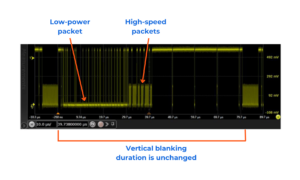
Technical Insights
New Realms of Rapid Application Development with Introspect’s Pinetree Software
3 min

Modern displays found in smartphones, tablets, and automotive screens need more information from the display controller than just the video stream. Functions like the driver volume control, brightness control, and debug information requests are all critical aspects which enable a smooth user-experience, yet are often overseen in testing. In this article, we demystify how these extra control packets are sent during the blanking of the main video stream. We also look at the benefits of using an SV3C-DPTX High-Performance MIPI D-PHY Generator to generate stimulus patterns for testing these features. Since maintaining a consistent line time is essential to the proper functioning of the DSI receiver, these extra packets must not affect the timings of the stream.
As MIPI defines it, a Display Serial Interface (commonly known as DSI) is a versatile, high-speed interface between a host processor and a display module. In tangible terms, this type of display is used in smartphones, tablets, laptops, automotive and other platforms. With the use of the interface, manufacturers can integrate displays to achieve excellent performance, low power consumption, and minimal electromagnetic interference (EMI), all while lowering the number of pins and retaining vendor compatibility. Designers love MIPI DSI thanks to its brilliant colour rendering for the most pristine imagery and video scenes.
To validate the functionality of a display, our D-PHY generator products such as the SV3C-DPTX can produce these extra packets for volume and brightness control (for example) when generating video-mode image patterns. This alternate pattern feature always respects the video timings of the video stream currently playing.
Here is an example of vertical frame blanking that can be found in a DSI frame:

Figure 1 shows a simple example with five (5) vertical front porch (VFP) lines, one (1) vertical sync active line (VSA) and one (1) vertical back porch line (VBP).
Using the alternate pattern feature, additional data can be sent during the low-power (LP) stop between VFP lines:

Note that the HSync packet of the first back-porch line is still in place, and that the total vertical blanking duration is completely unchanged. Critically, the video stream was not interrupted between the capture of Figure 1 and 2: it played continuously with the same video timings before and after the alternate pattern was sent. If the display is sensitive to timing accuracy, no flickering would be observed on the screen.
What happens if the alternate pattern is larger than the DSI linetime? In this case, the HSync packet of subsequent VFP lines is “hidden” by the alternate pattern as seen in Figure 3 below:

Again, note that the total vertical blanking duration is unchanged in the figure above.
Anything that can normally be generated by our normal command pattern can be used as an alternate pattern:
This feature is available for all video-mode DSI patterns, at any data rates supported by the hardware. The example above was done at 2.5 Gbps. The only restriction is that the alternate pattern must fit within the vertical front porch duration of the initial pattern. The alternate pattern can be sent exactly once, or multiple times.
As test and measurement instruments, Introspect’s D-PHY generator tools are an excellent fit for testing MIPI DSI. Not only can they perform standard pattern tests such as PRBS testing or standard display stream testing, but they can also be used to exercise very advanced features such as BTA and extra control packet transmission.
For any inquiries on Introspect’s SV3C-DPTX High-Performance MIPI D-PHY Generator or for how to use the alternate pattern features, send us an email at info@introspect.ca!
